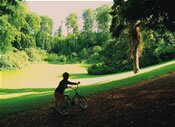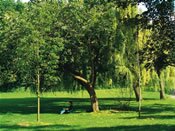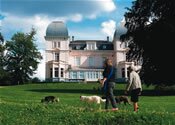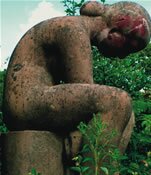Inflight Magazine of Brussels Airlines
Welcome to the Inflight Magazine of Brussels Airlines
Park life
Brussels might have a reputation as Europe’s bustling business capital, but once out of the city centre you’ll find yourself escaping to a green and pleasant land, reveals Lucy Mallows
 Despite what you might have thought about Brussels, it can get pretty steamy in the summer. At this time of the year, life is lived outdoors, sipping chilled Belgian beer at sun-drenched terrace cafés.
Despite what you might have thought about Brussels, it can get pretty steamy in the summer. At this time of the year, life is lived outdoors, sipping chilled Belgian beer at sun-drenched terrace cafés.
Near the centre of Brussels, the Parc de Bruxelles, the Parc du Cinquantenaire and the étangs (ponds) d’Ixelles offer a chance to catch one’s breath. Further out, most people can point you in the direction of the Bois de la Cambre, Parc du Woluwe or the Atomium’s verdant home in Parc d’Ossegem. However, if you’d prefer to avoid the crowds, hop on tram 55 and head to an undiscovered forest just south of Saint-Gilles.
Parc Duden and its neighbour Parc du Forest contain some of the best splashes of greenery in the city, but most tourist guides inexplicably omit to mention their charms. Here, you can chill out with the locals and take your pick from a wide selection of food and drink outlets. Visitors will find a haven of peace and tranquillity – except when the local football team is playing.
 The best way to reach the twin parks is to take tram 55 to the wonderfully named Silence terminus. Alight at Place de l’Altitude Cent and check out the unusual art deco church dominating the skyline of southern Brussels.
The best way to reach the twin parks is to take tram 55 to the wonderfully named Silence terminus. Alight at Place de l’Altitude Cent and check out the unusual art deco church dominating the skyline of southern Brussels.
The Saint Augustin Church was inaugurated in 1935 and was one of the first in town to be built in reinforced concrete. The pyramid-shaped building with its 54-metre-tall, four-sided bell tower was conceived by architects Léon Guianotte and André Watteyne based on mathematical equations. Located at one of the highest points in the capital and at a roundabout where eight avenues form a star, the church is an unmissable landmark in the urban landscape. There are several good bistros on the square and it’s a short walk along Avenue Rousseau to the parks.
Parc Duden and Parc du Forest, in typically contrary Belgian fashion, appear to be named back to front. The ‘forest’ is the open park area and ‘Parc Duden’ is the forest.
 The Parc du Forest is a magnificent swathe of manicured lawn filled with children playing football and locals enjoying picnics. In the summer it’s the site for funfairs, circuses and the occasional impromptu flea market.
The Parc du Forest is a magnificent swathe of manicured lawn filled with children playing football and locals enjoying picnics. In the summer it’s the site for funfairs, circuses and the occasional impromptu flea market.
On the Avenue du Parc are several excellent restaurants and bars with pavement terraces and there are always waffle and ice cream vans parked permanently by the lawn. From the terraced garden that marks an entrance to Parc Duden, visitors can look across the sweep of green all the way to the Palais de Justice in the centre and as far as Koekelberg basilica on the other side of town. Paths criss-cross the hilly park, leading up through pine trees inhabited by lime green parakeets, the extensive family of a pair of ingenious and remarkably fertile birds that escaped from Laeken zoo in the 90s and now create an Amazonian ambience with their exotic squawking.
 Follow the grand lawn in a southerly direction towards a simple metal arch statue and you’ll find Parc Duden, a magical woodland with a network of shaded trails surrounding a deep hollow where a clearing in the towering plane trees offers a peaceful sunbathing spot. Joggers, dog-walkers and those out for a Sunday afternoon stroll can all find a quiet haven in which to sit and contemplate the beauty of their surroundings.
Follow the grand lawn in a southerly direction towards a simple metal arch statue and you’ll find Parc Duden, a magical woodland with a network of shaded trails surrounding a deep hollow where a clearing in the towering plane trees offers a peaceful sunbathing spot. Joggers, dog-walkers and those out for a Sunday afternoon stroll can all find a quiet haven in which to sit and contemplate the beauty of their surroundings.
In the 18th century, the area belonged to the Forest Abbey and was part of a collection of woods extending south to the Forêt de Soignes. In 1869, a lace merchant bought the land and in 1895 bequeathed it to King Leopold II to transform it into a 22-hectare public park, which opened in 1912.
 Traces of the noble history can be seen in the heart of the woods, where the elegant, baroque Château Duden now hosts a college for young filmmakers. Football romantics should not miss this park during the soccer season, as it’s a chance to see Brussels’ oldest football club. The Royal Union St-Gilloise’s ground is located at the western side of the woods and was founded in 1897. If you’ve built up a thirst after all that walking, there are three pubs right opposite the wonderful Art Nouveau statues guarding the football ground’s entrance.
Traces of the noble history can be seen in the heart of the woods, where the elegant, baroque Château Duden now hosts a college for young filmmakers. Football romantics should not miss this park during the soccer season, as it’s a chance to see Brussels’ oldest football club. The Royal Union St-Gilloise’s ground is located at the western side of the woods and was founded in 1897. If you’ve built up a thirst after all that walking, there are three pubs right opposite the wonderful Art Nouveau statues guarding the football ground’s entrance.
There’s also the Club House, which never seems to close.
Getting there
Parc Duden and Parc du Forest tram 55 from Bourse to Place de Altitude Cent in the direction of the tempting tram terminus Silence
Parc Duden has gates that close at night, although you can escape through the bushes if they lock you in. Open Nov-Feb 7am-5pm, Mar and Oct 7am-6pm, Apr and Sep 7am-7pm, May-Aug 7am-8pm
Le Lorada Place de l’Altitude Cent on corner with Avenue Everard, next to Delhaize Proxy supermarket
Schievelavabar Place de l’Altitude Cent 8, on corner with Avenue Saint Augustin, tel. . Another bar following the famous bar Schievelavabo (the ‘wonky washbasin’)
Saint-Augustin Church Place de l’Altitude Cent, tel. . Guided tours (free and in French) on the fourth Sunday of each month at 2.30pm give access to the crypt and the tower with its panoramic views of southern Brussels
Royal Union St-Gilloise Stade Joseph Marien, Chaussée de Bruxelles 223, tram 52 from Bourse, tel. , www.rusg.be. Admission €10 standing, €15 sitting
Nemea Greek Restaurant Avenue du Parc 159, tel, , open Thursday-Tuesday noon-3pm and 6pm-midnight
Union’s Taverne Chaussée de Bruxelles 266 offering Jupiler, Maes and Grimbergen, with a jukebox and restaurant
Copacabana Café Chaussée de Bruxelles 298, serving food and endless varieties of beer with a tiled floor and pool table
Leave a Reply
